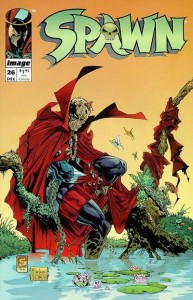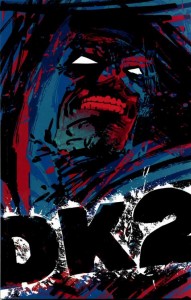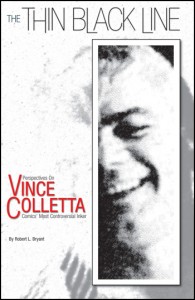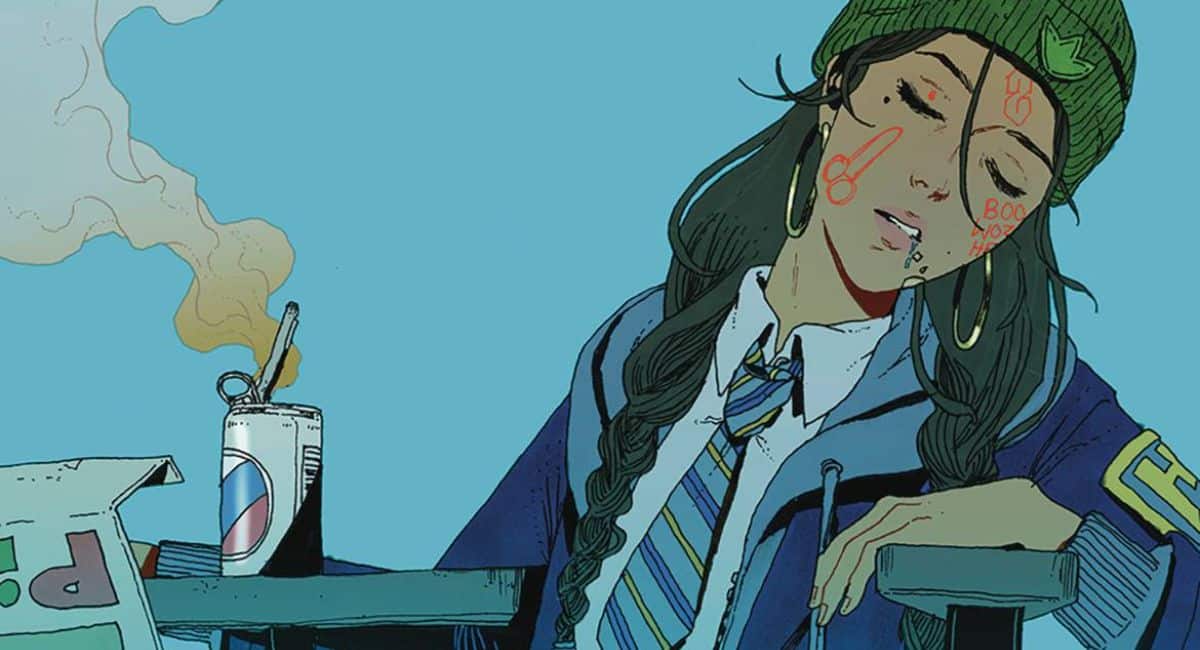
Personally, I’m fascinated with Crabb’s use of Spawn continuity to justify her decision:
“According to the rules of the Spawn universe, only one Hellspawn could be on Earth at the same time and the [original] Al Simmons Hellspawn was already around. […] Much as defendant tries to distinguish the two knight Hellspawn, he never explains why, of all the universe of possible Hellspawn incarnations, he introduced two knights from the same century. Not only does this break the Hellspawn ‘rule’ that Malebolgia never returns a Hellspawns [sic] to Earth more than once every 400 years (or possibly every 100 years, as suggested in Spawn, No. 9, exh. #1, at 4), it suggests that what defendant really wanted to do was exploit the possibilities of the knight introduced in issue no. 9.”
I want Rob Liefeld and Marvel in a Wisconsin court now, just to get Crabb’s take on how X-Man and Agent X are, or are not, derivatives of Cable and Deadpool.
At his Web site, Kurt Busiek elaborates on the genesis of the in-the-works Astro City film. In particular, he explains his initial reluctance to have one made:
“[…] I had a little patter worked up, where I pointed out that what’s important about Astro City are the characters, the relationships, the emotional connections of the story. The big superhero action and explosions and such were important too, but they were the context, while the humanity of the characters was the real meat of the story. So you’d be telling a story that’s all about relationships and emotion, but you still have to pay for all those special effects. “Basically,” I’d say, “in Hollywood terms it’s a $200 million chick flick. No one’s going to make one of those.” And then Titanic came out and I had to stop saying that.”
If Busiek has his way and the film gets made and released, which always seems like a long shot until it’s in the past, it looks like it could end up being what a lot of people have been waiting for: a good film with a mature take on the notion of superheroes that doesn’t collapse under its own pretense.

“I had a talk with [then-DC publisher] Paul Levitz and I said, ‘Look, this isn’t your Batman. I pushed Batman as far as he can go and after a while he stops being Batman. My guy carries a couple of guns and is up against an existential threat. He’s not just up against a goofy villain. Ignoring an enemy that’s committed to our annihilation is kind of silly, It just seems that chasing the Riddler around seems silly compared to what’s going on out there. I’ve taken Batman as far as he can go.”
The “existential threat” Miller refers to, again, is Al Qaeda.
Now, personally, I’m rather disappointed. The prospect of seeing a character like Batman grapple with a real-life threat like Al Qaeda was what made me look forward to the project—not because I’m a big Batman fan (I’m probably not), but precisely because of the seemingly irreconcilable clash of sensibilities outlined by Miller in the quote above. I was curious what a bold, self-confident, accomplished storyteller like Miller was going to make of that.
Sure, judging from The Dark Knight Strikes Again and All Star Batman, it was going to be utterly and hopelessly mad and preposterous. But Miller being Miller, it was going to be mad and preposterous in a good way, and it was also going to be more than that.
Without Batman in there, I’m still interested, but it seems like Miller is surrendering. The resulting book will probably be a little bit less ridiculous, less bold and less memorable as a result. In other words, Frank Miller is the last person on the planet I want to worry how far Batman can go. Instead, I want the character dragged there and beyond, kicking and screaming if need be.
That’s where the fun is, right?
o “All-New, Comic Book Universe Continuity”
It seems WildStorm has found its new niche in the market.
In addition to publishing Alan Moore comics without Alan Moore (Tom Strong and the Robots of Doom) and Grant Morrison comics without Grant Morrison (The Authority: The Lost Year), on the horizon now are Warren Ellis comics without Warren Ellis.
They come in the shape of various one-shot prequels to Ellis’s 2003 miniseries Red with artist Cully Hamner, which is soon to come out as a film. The original miniseries was three issues. The number of new “prequel” comics? Five.
To be fair, one of the new books is written and drawn by Hamner himself, but let’s be honest: It doesn’t look like WildStorm is even trying anymore, does it?

Recently, Colletta’s letter to Marvel in the wake of longtime editor-in-chief Jim Shooter’s ouster in 1987 resurfaced again. That missive suggests, if nothing else, that (a) Colletta was a rather outspoken fellow who didn’t mince words, even when it was sure to burn bridges, and (b) he was also a supporter of Jim Shooter, another controversial figure.
Based on that alone, it’s no surprise that Colletta still tends to polarize when his name comes up. Simply put, a guy who writes—and mails—letters like that one doesn’t just have friends in the world. Add the ongoing debate over the merits of his actual work—or lack thereof, depending on who you as—and Colletta is easily one of the most intriguing personalities in North American comics.
Marc-Oliver Frisch writes about comics at his weblog and at Comicgate. You can also follow him on Twitter.




Would that Frank Miller had enough of this sense of character to stop himself during the filming of Will Eisner’s The Spirit.
“I want Rob Liefeld and Marvel in a Wisconsin court now, just to get Crabb’s take on how X-Man and Agent X are, or are not, derivatives of Cable and Deadpool.”
But what difference would it make, since they were all work-made-for-hire and thus entirely the property of Marvel Comics?
The issue with Medieval Spawn is that it WASN’T WfH, and thus Gaiman has rights to the character even if it is derivative (which he has never denied). And since Dark Ages Spawn is derivative of Medieval Spawn, Gaiman has rights to it as well. That’s why Marvel & DC use WfH contracts for their house characters, so ownership issues like this won’t come up.
“But what difference would it make …”
None. I just want to read the Judge’s very detailed, continuity-based opinion.
I thought Liefeld does get royalties off of the use of Cable and Deadpool (or at least any titles characters star in)?
The real problem with Colletta was that he just didn’t have any respect for the artform. It was all just a job to him, and the less that he did, the more money that he made. Hence, he was well known for erasing entire panels of backgrounds and just hacking out figure inks. Pencil artists lived in fear tha the would be assigned him as an inker. As anyone can attest, having a co-worker in your business who is so incredibly selfish and unwilling to consider the feelings and work of others is just someone who will eventually live in infamy as one of the worst examples of the craft.
Vince Colletta’s inks on some of our favorite artists were admittedly a poor turn at the lush possibilities of the original pencils or the original artist’s intent.
But, Marvel and DC both had contracts with printers to have certain books running on the presses on certain dates, if an artist or letterer (back in the day when they actually lettered on the boards before they were inked) was late for any reason, someone had to do the catching up.
It’s my understanding that Vince was sometimes instructed to get the job done and get it done in the time that was available.
Now, we look back on his inking over Kirby as ruined treasures, but at the time they were trying to put out a commercial product on a timely basis.
Yeah, I agree that his inks wrecked the potential of Kirby’s pencils but I saw other artists do the same. I once saw George Bell’s (George Roussos)inks on the actual pages of a Kirby, NICK FURY AND THE HOWLING COMMANDOS, story at the Words and Pictures Museum in North Hampton, Mass. I told George that I had seen the story and it looked beautiful. He said, “Ah, I inked that over the weekend.” There is no possible way George could have inked that many pages so well over the course of two or even three days. Later, I saw a Kirby FANTASTIC FOUR story he had inked, it was terrible, the lines were scratchy, the backgrounds weak, that, was the Kirby story he inked over the weekend.
We like to think of these artists pursuing loftier goals with our favorite heroes but sometimes it just comes down the strictures of producing a commercial product.
All I’m saying is, maybe we shouldn’t kick Vinny Colletta around so much.
Miller and Al Q, might be a good thing that Batman is not involved. I used to jump on news that Miller had a new project in the pipeline. Daredevil and the great Batman year one were great. Sin City is great for the first creator owned work,but after it went on it ran out of steam. Great crime noir like “year one” and daredevil we should cherish it. But Al Queda mmm i don’t know.
(edited)
Why would anyone who has more lucrative options waiting outside of comics devote their time to making comics? It’s a lose-lose situation!
Wildstorm’s exploiting its IP library. Given the rumors about Watchmen sequels and prequels, this should be expected of them. Its management has done its best to drive away all high-quality content and instead is offering sequels to past hits. Publishing Alan Moore comics without Alan Moore, Grant Morrison comics without Grant Morrison, horizon and Warren Ellis comics without Warren Ellis may be cheaper than putting on the, as Vince Colletta would say, “Prima Donna free lancers ” themselves and maybe that may be part of why Wildstorm is relanching its pseudo-franchises. I’d hate to think they’re doing it to attract film studios or keep copyrights. Wildstorm’s real purpose seems to be a licensing vehicle for DC. DC’s brand must not be cool enough to directly license stuff directly under
I liked Vince Colletta’s inking. I hope that the book shows some that I haven’t seen before.